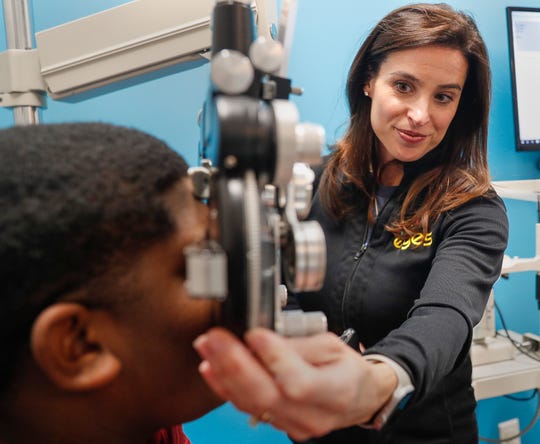The number of nearsighted kids is soaring — and the reason why may not be what you think
by Shari Rudavsky, Indianapolis Star, Dec 2nd, 2019 – View the full article here.
When her oldest child came home from school and said vision screening had revealed he would need bifocals, Kailey Welch was shocked. He was only 12.
Sure, she wore prescription lenses herself, but she didn’t start until she was well into adulthood. To her greater surprise, three of Welch’s seven other children also have needed glasses. Today, the four oldest of the eight children in her blended Greenfield family must wear glasses for up-close work.
The likely reason, according to her doctor: devices, both at home and at school.
Now, the Greenfield mother closely monitors the younger four children’s screen time and tries to ensure that the older four wear glasses when reading.
“I’m definitely paying more attention to it,” Welch said.
So are eye specialists. The Welch family represents a trend that they have been watching with some alarm for the past decade — a steep increase in the number of children who require corrective lenses.
Screens are an easy culprit, but experts suspect that is only part of the explanation. Exposure to sunlight may play a role. More time spent outdoors appears to ward off the need for glasses. Increased awareness among parents to have their children’s eyes screened combined with simple genetics also factor in to the equation.
But pinning down exactly why continues to vex the field.
“That’s kind of the million dollar question now,” said Dr. Katherine Schuetz, a pediatric optometrist with Little Eyes in Carmel. “In our profession, we’re trying to figure out why and fix it.”
Vision troubles are a rising concern
When Gen Xers were young in the ’70s, about 20% of children in the United States needed glasses. Now that number has inched closer to 40%, said Dr. David Epley, a clinical spokesman for the American Academy of Ophthalmology.
Other estimates say the percentage of youth with myopia or nearsightedness is even greater, in excess of 45%, said Dr. April Jones, a pediatric optometrist with Riley Childrens Health. By 2050, estimates suggest that as much as a quarter of the world may be nearsighted.
Just two decades ago when Schuetz started in practice, she saw far fewer young patients who required lenses than she sees today. The biggest increase she is seeing comes in children between age 4 and 12.
Nor is the issue just that children with poor vision are showing up younger and younger. Once their eyesight requires corrective lenses, it’s deteriorating faster and faster.
“We do know that genetics play a role, but more and more environment and lifestyle are having a bigger impact than in the past,” Jones said.
Across the globe, researchers note that children in certain countries are more likely to wear glasses than in others. In many parts of Asia, for instance, as many as 90 percent of children have myopia, one 2012 study found. By contrast, other countries such as Australia boast a lower percentage of children with myopia than the U.S.
What might be contributing to the problem
Genetics alone cannot explain such differences. So specialists suggest it’s a combination of factors, starting with screen use.
“There’s probably a partial truth in there,” said Epley, a pediatric ophthalmologist in Kirkland, Washington, of the tendency to blame screens.
Exposure to sunshine, however, may be just as important if not more, experts are beginning to believe. Again, it’s not clear exactly why, but natural sunlight appears to stabilize vision regardless of whether a person uses screens.
In addition, when a child is outside playing, that is time he or she is not bent over a screen, making outdoor time even more important, the experts say.
Studies suggest that exposing the eye to a spectrum of light may prevent the development and progression of myopia, but yet again, it’s unclear why, Epley said.
Skeptics may note that children have been reading books for centuries and that has not had as great an impact, but screens are not exactly equivalent.
In general close work, whether staring at a screen or a book, strains eyes. When a person reads, however, he or she tends to hold the book farther away than a phone or tablet, perhaps because books are bigger.
Holding objects closer to the eye flexes muscles in the eye that may wind up telling the body to grow the eyeball, Jones said. While the eyeball naturally lengthens over time and a certain amount of growth each year is expected, screen use may speed up the process, resulting in myopia.
Eventually a person may develop high myopia, which in addition to requiring him or her to wear corrective lenses raises the risk later in life of complications such as retinal detachment, premature cataracts, glaucoma and…
This article is continued at IndyStar.com – View the full article here.



